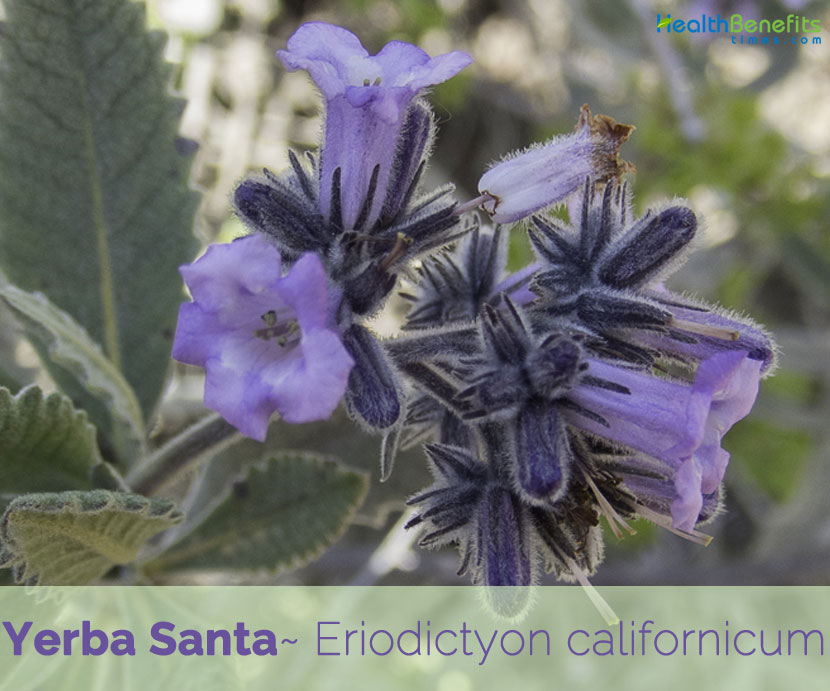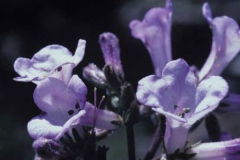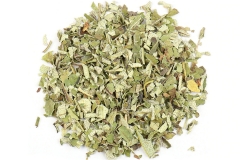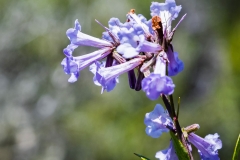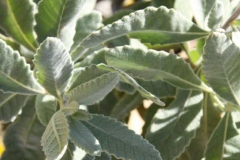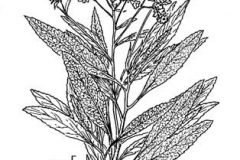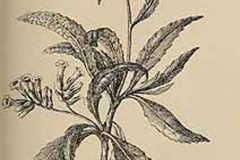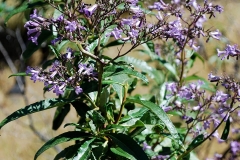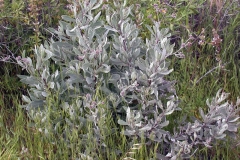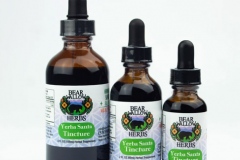Leaves were used by Native American people like the Chumash people as a traditional medicine, and they are traditionally administered as a poultice or as a steam treatment. It was later introduced to early Spanish settlers who originally named it Yerba Santa or “Holy Herb” because it was so effective at treating respiratory ailments. It was also used less frequently to treat external conditions like bruises, wounds, bugs bites, and even hemorrhoids, although those conditions are not frequently treated using Yerba Santa today.
Yerba Santa Facts
| Yerba Santa Quick Facts | |
|---|---|
| Name: | Yerba Santa |
| Scientific Name: | Eriodictyon californicum |
| Origin | California, Arizona, Nevada, Oregon, and Northern Mexico |
| Shapes | Small capsule, 0.08 to 0.12 inch (2-3 mm) long |
| Taste | Sweet, slightly bitter taste |
| Health benefits | Respiratory conditions, Cancer, Asthma, Cures Mouth Diseases, Cures Cough, Cures Digestion, Allergies, Bronchitis, Acute illnesses, Skin conditions, Smudging |
| Name | Yerba Santa |
|---|---|
| Scientific Name | Eriodictyon californicum |
| Native | Hills and mountains of California, Arizona, Nevada, Oregon, and Northern Mexico |
| Common Names | Bear’s weed, Consumptive’s weed, Eriodictyon, Gum plant, Mountain balm, Tarweed, Yerba santa, gum bush, Hierba Santa, Holy Herb, Tarweed, Herbe des Montagnes, Herbe à Ourse, Herbe Sacrée, Herbe Sainte, sacred herb |
| Name in Other Languages | English: California yerba santa, Mountain balm, yerba santa Spanish: Hierba santa, Yerba-santa Swedish: Balsambuske |
| Plant Growth Habit | Low, erect, much-branched, native evergreen, aromatic shrub |
| Growing Climates | Occurs on dry, rocky slopes, ridges, coast redwood forests, dry rocky hillsides and ridges, patches on chaparral slopes, forests, canyons, along riverbanks, grasslands and oak woodlands |
| Soil | Grows in shallow to deep, slightly acidic soil. Soil texture varies from sandy loam to heavy clay. It will tolerate serpentine soil |
| Plant Size | 2 to 8 feet (0.6-2.4 m) in height |
| Root | Shallow, with multi branching rhizomes. Most of the main roots are confined to the top 3 inches (7.6 cm) of soil |
| Stem | Smooth, usually branched near the ground, and covered with a peculiar glutinous resin, which covers all the upper side of the plant |
| Leaf | Thick, tough and leathery, smooth, of a yellowish color. Their upper side is coated with a brownish varnish-like resin, the under surface being yellowish-white reticulated and tomentose |
| Flowering season | July to August |
| Flower | White to lavender or purple in terminal clusters of six to ten, in a one-sided raceme, and shaped somewhat like little trumpets |
| Fruit Shape & Size | Small capsule, 0.08 to 0.12 inch (2-3 mm) long, containing 2 to 20 small black seeds |
| Flavor/Aroma | Unpleasant odor |
| Taste | Sweet, slightly bitter taste |
| Plant Parts Used | Dried leaves |
| Available Forms | Extracts, infusions, tonics, tinctures, capsules and poultice |
| Season | September |
| Health Benefits |
|
| Other Facts |
|
Plant Description
Yerba Santa is a low, erect, much-branched, native evergreen, aromatic shrub that normally grows about 2 to 8 feet (0.6-2.4 m) in height. The plant is found growing on dry, rocky slopes, ridges, coast redwood forests, dry rocky hillsides and ridges, patches on chaparral slopes, forests, canyons, along riverbanks, grasslands and oak woodlands. The plant grows in shallow to deep, slightly acidic soil. Soil texture varies from sandy loam to heavy clay. It can also tolerate serpentine soil. Root system is shallow, with multi branching rhizomes. Most of the main roots are limited to the top 3 inches (7.6 cm) of soil. Stem is smooth, usually branched near the ground, and covered with a peculiar glutinous resin, which covers all the upper side of the plant.
Leaves
Leaves are thick, tough and leathery, smooth and yellowish color. Their upper side is coated with a brownish varnish-like resin, the under surface being yellowish-white reticulated and tomentose, with a prominent midrib, alternate, attached by short petioles, at acute angle with the base; shape, elliptical, narrow, 2 to 5 inches long and 3/4 inch wide, acute and tapering to a short leaf-stalk at the base. The margin of the leaf, dentate, unequal, bluntly undulate. Foliage and twigs are covered with shiny resin and are often dusted with black fungi, Heterosporium californicum.
Flowers and Fruits
Flowers are white to lavender or purple in terminal clusters of six to ten, in a one-sided raceme, and shaped somewhat like little trumpets. The corolla is funnel-like and calyx sparsely hirsute. Flowering normally takes place from July to August. Fertile flowers are followed by small capsule, 0.08 to 0.12 inch (2-3 mm) long, containing 2 to 20 small black seeds.
Health benefits of Yerba Santa
Listed below are few of the well-known health benefits of Yerba Santa
1. Respiratory conditions
Yerba santa is popular for its use in respiratory conditions, mainly when there is a lot of mucus stuck in the body. It is considered one of the best decongestants, working as an expectorant by breaking up thick mucus and facilitating its expulsion from the body. For acute colds and coughs with upper respiratory and sinus congestion, yerba santa is extremely helpful. As a muscle relaxant, yerba santa works well for asthmatics as it dilates the bronchial tubes and allows air to flow more easily into the lungs. For asthma, yerba santa is often smoked in a pipe, for instance.
2. Cancer
Research conducted in 1992 was able to isolate twelve compounds called flavonoids that inhibited the growth of cancer cells in cultured hamster embryos. From this research, they concluded that the plant may be able act as a cancer preventative therapy, and therefore it permits further study on live animals. From this study, they also determine that the plant also contains an antibiotic compound called eriodictyol.
3. Asthma
Native Americans would often smoke or chew the leaves as a treatment for asthma. Tonic or tea made from the leaves of the plant is also useful for treating chronic asthma, and this method was often used by early European settlers in the western U.S. Although research in this area is lacking, many people who purchase Yerba Santa supplements and extracts claim that they found using Yerba Santa was more effective and easier to administer than typical asthma treatments. In several cases customers say that a single drop helps ease the symptoms of asthma anywhere from 4 to 24 hours.
4. Cures Mouth Diseases
The excess saliva produced when chewing Yerba Santa makes it effective in treating chronic dry mouth. Additionally, the sweet taste produced by the leaves is also effective in treating foul breath. Apart from chewing the raw leaves, oral sprays made from Yerba Santa are available, and reviews of those sprays are mixed, with some suggesting that they prevent oral dryness brought on by sleeping, and with others saying the effects are not long lasting. Research show that Yerba Santa based oral sprays can provide relief for up to two hours after use. Spray formulas also tend to be designed to prevent tooth decay as well.
5. Cures Cough
Research suggests that using an aerosol spray made from a Yerba Santa extract helps to prevent dryness of the mucosal membranes of the upper and lower respiratory tract. Also it prevents the lungs from the irritation of bacteria and reduces coughing. Further research shows that the plant can reduce the amount of phlegm produced by the lungs while also addressing inflammation of the mucus-producing tissues, making it great for clearing up the “moist” parts of a cold, like runny noses. Testimony also recommends it is great for treating persistent coughs that did not respond to other medications.
6. Cures Digestion
Traditionally, the leaves of Yerba Santa would be rolled into a ball and then chewed in order to promote saliva production. This excess saliva consists of digestive enzymes that help to orally digest food, then ease an upset stomach, and improve digestive function. The herb is also thought to help increase appetite, improve bowel movements, and reduce gas and bloating. Although most people who purchase Yerba Santa products do so with the intentions of treating respiratory conditions, testimony suggests that many also see improvements in the digestive system as well.
7. Allergies
Although there is not much research in this area, Yerba Santa is beneficial in clearing out the mucus caused by allergies and ridding the body of continually congested sinuses. It is also said to supplement the flow of urine, detoxifying the body of allergens. Many customers say that the herb is very useful in treating allergies when used in tea. Moreover, nasal sprays are also very popular among those who use the herb, and many say it is very effective in providing relief to a dry, irritated nose. Providing this moisture to the nasal passage also allows the nose to clear out trapped allergens.
8. Bronchitis
Yerba Santa was often used as a common medical practice to treat bronchitis starting in the early 1800s up until the 1960s, until laws became stricter. Because of this there is unclear scientific evidence for this use. Many still use a Yerba Santa poultice to treat lung conditions like bronchitis by placing damp leaves on the chest. Many who have bought Yerba Santa extracts say that it is very effective in relieving tightness in the chest brought on by bronchitis.
9. Acute illnesses
At the onset of a cold, especially when there is a cough or bronchial irritation, yerba santa can eliminate or at least relieve the symptoms.
10. Skin conditions
Poultice of yerba santa can be applied to bruises, insect bites, sprains, and wounds.
11. Smudging
Smudging is a traditional Native American practice where herbs are burned as incense for numerous reasons. Yerba Santa is one of several herbs used in infant smudge bundles used to bring health to young children as well as in ceremonial smudge bundles used to honor ancestors, increase physic abilities, and bring health and protection. The bundle would be burned and allowed to smolder during this process. While not tested scientifically, many people who purchase smudge bundles claim that burning them creates a calming environment that releases negative energy.
Traditional uses and benefits of Yerba Santa
- Yerba Santa is a famous domestic remedy from south-western N. America where it is considered to be particularly useful as an expectorant.
- It is an ingredient of many obvious cough medicines.
- Leaves are an aromatic pleasant tasting tonic herb that reduces spasms, expels phlegm and lowers fevers.
- They are especially suggested for treating diseases of the chest and respiratory system, including asthma, and are also used in the treatment of hay fever.
- Bitter tea made from the leaves has been much used as a bitter tonic and a stimulating balsamic expectorant.
- Steam bath made from the branches and leaves has been used in the treatment of rheumatism.
- Decoction of the leaves has been used as a wash for sore areas and painful fatigued limbs.
- Natural mouthwash is prepared by rolling the leaves into balls and allowing them to dry in the sun.
- The plant has been smoked as a remedy for asthma.
- It is used medicinally for the management of bruises and rheumatic pain.
- Plant also has been used as an expectorant and in the treatment of respiratory diseases.
- Thick sticky leaves, used either fresh or dried, were boiled to make a tea or taken as treatment for coughs, colds, asthma, and tuberculosis.
- Leaves have been powdered and used as a stimulating expectorant.
- Liniment was applied topically to reduce fever.
- Poultice of fresh leaves was used to treat bruises, and young leaves were applied to relieve rheumatism.
- Yerba santa has been used as a pharmaceutical flavoring, mostly to mask the flavor of bitter drugs.
- Recommended for bronchial and laryngeal troubles and in chronic pulmonary affections, in the treatment of asthma and hay-fever in combination with Grindelia robusta.
- It is recommended for hemorrhoids and chronic catarrh of the bladder.
- Leaves have historically been used to treat asthma, upper respiratory infections and allergic rhinitis.
- The Chumash used it as a poultice for wounds, insect bites, broken bones, and sores.
- Sticky aromatic leaves are used in treating bronchial and pulmonary illnesses.
- It is a good herbal remedy for countering respiratory problems as Asthma, Chest Congestion, Flu, Bronchitis, Pneumonia, Cold, and Dry Cough. It enhances the breathing capacity by loosening the accumulated Phlegm.
- It alleviates the symptoms of Indigestion like Acid Reflux, throwing up and Stomach pain.
- It is a good herbal cure for Joint troubles like rheumatism, rheumatic arthritis and muscular troubles like spasm and sprain.
- It calms the infection relating to the upper respiratory tract as throat infection, tracheitis and laryngitis.
- It heals wounds and bruises rapidly.
- It is beneficial in combating fever and eases the condition of Rhinitis i.e. Hay Fever.
- It is beneficial in curbing Skin troubles like Sores, Allergies and Ageing.
- It is beneficial in treating the condition of diarrhea and dysentery.
- It relieves the pain caused by sinusitis.
- It prevents dry mouth and keeps it moist.
- It counteracts pleurisy.
- It aids in tackling tuberculosis.
- It suppresses tiredness i.e. fatigue.
- It is an antidote for insect bites.
- Poultice of leaves may be applied to flesh wounds, sore muscles, above bone fractures, and where rheumatism strikes.
- It is used in treating bronchial and laryngeal troubles and chronic pulmonary affections, and also for asthma and hay-fever.
- It is considered to be a precious expectorant and is used to cure ailments like tracheitis, bronchitis and asthma and other respiratory tract disorders.
- It is also effective in curing insistent pulmonary infections, hay fever and asthma and is an excellent blood purifier.
- Decoction of the leaves has been used as a wash for sore areas and painful fatigued limbs.
- Fresh leaves are chewed for their refreshing taste and to relieve thirst.
- It has also been found effective for a number of symptoms, including gastrointestinal disorders and fatigue.
- When used externally for bruises, mosquito bites, or sprains, yerba santa can be applied as a poultice.
- Herb is also used as a tonic to cleanse the blood, tone the nervous system, stimulate the mind, and control the appetite.
- Its leaves warm and encourage the respiratory system; reduce inflammation in the sinuses, throat, and lungs; and dry excessive secretions of the lungs or upper respiratory tract.
- Leaf tincture relieves chronic asthma, bronchitis, or seasonal allergies accompanied by copious and easily expectorated mucus discharge.
- Cooled tea or the tincture in room temperature water speeds the healing of urinary tract infections characterized by mucus discharge.
- Tea drunk hot or the tincture in hot water promotes sweating and increases circulation to the extremities and the surface of the skin.
- Leaves and flowers were made into a “bitter or sweetish-soapy” tasting tea that was drunk to relieve headaches and other symptoms of tuberculosis.
- Infusions of Yerba santa leaves and flowers were used to treat fevers, coughs, colds, stomachaches asthma, rheumatism pleurisy, and to purify the blood.
- The Kawaiisu drank Yerba Santa tea instead of water for a month to treat gonorrhea.
- The Salinan used an infusion of the leaves as a balm for the eyes.
- Heated leaves were placed on the forehead to relieve headaches and other aches and sores.
- Mashed leaves were also used to reduce the swelling and relieve pain caused by bone fractures, sores, cuts, wounds, and aching muscles.
- Decoction prepared with leaves of yerba santa has been used in the form of a mouthwash for painful and exhausted members’ tender areas.
Ayurvedic Health benefits of Yerba Santa
- Muscle Sprains, Bruises: Make a poultice of fresh or dried Yerba Santa leaves and apply externally for Muscle Sprains, Bruises.
- Insect Bites: Grind some fresh leaves and apply the paste on affected area. It also reduces Swelling.
- Pain: Crushed leaves of Yerba Santa can be applied externally to treat all types of Pains.
- Bad Breath: Take some fresh leaves and roll them to form small balls. Put these balls in the sun for some days. Chew these dried leaf balls to get rid of Bad breath. Initially, they have a bitter taste, but soon this flavor changes into sweet taste.
- Expectorant: Take a cup of boiling water. Put One tablespoon crushed leaves in it and steep for 10 minutes. Strain and drink Luke warm.
- Wounds: Mash leaves and apply to cuts and wounds to reduce swelling and relieve pain.
- Rheumatism, Sore Muscles, Joint Inflammation: Steep 5 young leaves in hot water soak a washcloth as a compress and apply to area of pain.
- Decongestant: Cover 3 – 5 leaves (fresh or dry) in a cup with boiling water and let steep for 15 minutes to reduce mucous.
Culinary Uses
- Fresh leaves are chewed for their refreshing taste and to relieve thirst.
- An aromatic sweet tea is made from the fresh or dried leaves.
- An extract of the leaves is used as a flavoring in baked goods, sweets, ice cream and soft drinks.
- The fluid extract is used in foods and beverages.
Precautions
- It is not recommended during breast feeding or pregnancy.
- Iron & other minerals absorption can be affected by Yerba Santa.
- Large doses can be harmful for the Kidneys.
- It is also an herb that should not be used by people who are suffering from chronic gastrointestinal disorders.
- It should also be used sparingly by those who have sleep disorders or bouts of insomnia.
- Yerba santa may cause sleeplessness and contribute to a lack of appetite.
References:
https://www.itis.gov/servlet/SingleRpt/SingleRpt?search_topic=TSN&search_value=31373#null
https://pfaf.org/user/Plant.aspx?LatinName=Eriodictyon+californicum
https://www.drugs.com/npp/yerba-santa.html
https://botanical.com/botanical/mgmh/y/yersan07.html
https://plants.usda.gov/core/profile?symbol=ERCA6
https://www.fs.fed.us/database/feis/plants/shrub/erical/all.html
https://en.wikipedia.org/wiki/Eriodictyon_californicum
https://www.wikidata.org/wiki/Q3056647
http://www.theplantlist.org/tpl1.1/record/kew-2795509
https://gd.eppo.int/taxon/ERTCA
https://www.fs.fed.us/wildflowers/plant-of-the-week/eriodictyon_sp.shtml
https://www.encyclopedia.com/medicine/encyclopedias-almanacs-transcripts-and-maps/yerba-santa
https://plants.usda.gov/plantguide/pdf/cs_erca6.pdf


